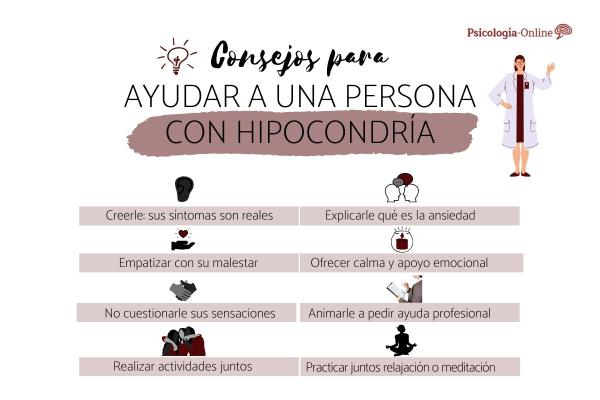
Hypochondria is understood as excessive and uncontrolled concern about suffering from a serious illness, based on the erroneous interpretation of bodily sensations or physical symptoms perceived in the body. These symptoms do not correspond, however, to any medical condition, which does not satisfy the hypochondriac person who is convinced that he is affected by some disease.
In the following PsychologyFor article we will talk to you about the origin and maintenance of this disorder, how to treat it clinically and in the family environment and what are the different techniques that are used to address the problem so that you know how to help a hypochondriac.
Why do you always think you are sick?
Hypochondria hides fear. Fear and anxiety are understood as basic survival emotions that prepare us to fight or flee in the face of imminent danger. When this happens, our body begins to emit its own physiological signals for fight or flight: breathing speeds up, the heart beats faster, etc.
The problem arises when there appears to be no real danger in the face of the fear or anxiety we feel. However, the body sensations We experience them equally. In these cases, the person is not aware of the fear that underlies these signs and interprets them as causes of a serious illness. From here on, he becomes hypervigilant with two negative consequences that feed his hypochondria:
- On the one hand, his hypervigilance It leads you to pay only attention to these signs, without taking into account those that may rule out your illness (for example, when you are distracted and do not think about your problem, the symptoms do not appear).
- On the other hand, this irrational control leads you to perceive the minimum “expected” somatic manifestation, which increases your anxiety. This anxiety generates new symptoms that confirm the patient’s initial beliefs.
How to treat a hypochondriac: management guidelines in Primary Care
Primary Care services are the first contact with hypochondriac patients. In order to care for them properly but prevent them from attending excessively, some guidelines are recommended to follow:
1. Establish a “therapeutic relationship” with the patient
A large component of hypochondria has an emotional substrate and support that provides security and trust can greatly contribute to the reduction of symptoms. This climate of trust will facilitate, in the event that the symptoms are not reduced, the patient’s acceptance of the treatment. proposal for a complementary psychological therapy.
2. Schedule appointments
Schedule and agree on a calendar of regular appointments that shows our interest in the patient and, at the same time, limits their visits to the health center.
3. Present the functional analysis of the problem
Explain to them in a respectful manner the etiology of their symptoms and their maintenance so that they understand the internal workings of their discomfort.
4. Offer simple techniques
If the client is receptive in this sense, they can be offered tools to stop and combat their pathological functioning: relaxation and breathing techniques, physical relaxation exercises, etc.
5. Avoid unnecessary interventions
Avoid hospitalizations, unnecessary tests and drugs with addictive potential, if not strictly necessary due to the severity of the symptoms.
6. Psychoeducate the family
Clarify to the family what attitudes and behaviors (family) favor or reduce their hypochondriacal behavior. In this way, the family can become another point of support and containment for the patient. Next we will see how the family can act to help a hypochondriac.
What to do to help a hypochondriac in the family environment
The family plays an important role in amplifying or reducing the symptoms of hypochondriac patients. Some of the elements that contribute to reducing the patient’s anxiety and, therefore, their symptoms are:
7. Empathize and validate
Accept that the person truly suffers from their disorder and that their physical sensations are real. He is not making this up and it is something that should never be questioned.
8. Try to focus attention on other things
Leave health/illness issues aside. On some occasions, this can be complicated since the same family context favors hypochondria by having repeated conversations about fears, weaknesses and illnesses.
9. Try to prevent unnecessary actions
Prevent unnecessary visits to health centers.
10. Share activities
Perform tasks and maintain positive conversations that allow the patient to have alternative experiences to their negative symptoms to resort to in moments of distress.
11. Accompany with calm and affection
Offer peace of mind and emotional support to the family member at critical moments, which will help reduce symptoms.
Techniques to work on hypochondria
The main objective, according to psychiatrist Vanesa Pastorelli, is twofold:
- On the one hand, establish a relationship of trust with the patient so that they feel safe, which will help reduce their symptoms
- Change the focus of attention: from non-existent medical illness to unconscious psychological causes. From here, look for them, recognize them and accept them as the origin of the problem.
There are many possible techniques and treatments to address hypochondriac disorder:
12. Pharmacotherapy
Psychotropic drugs have limited effectiveness and are not necessary in all cases.
13. Physical reactivation and physiotherapy
Gradual and progressive exercise programs improve the health and well-being of patients and reduce their symptoms.
14. Relaxation therapies
From breathing to progressive muscle relaxation, relaxation techniques help reduce anxiety levels.
15. Behavioral treatment
Through gradual exposure to symptoms and prevention of behaviors of interpretation of physical signs. Here you can see more information about the exposure technique in psychology.
16. Cognitive therapy
We work with the thoughts that generate fears and, with it, the physical manifestations. Modifying negative thoughts with positive ones stops the fear and, consequently, the symptoms.
17. Dynamic psychotherapy
Psychoeducational and support techniques based on introspection to become aware of how the problem originates and is maintained and, from there, adopt an attitude of responsibility towards one’s own health and stop the process by modifying thoughts, emotions and actions
18. Group psychotherapy
Very useful in these cases as it helps to become aware that hypochondria is real when seen in other people. It helps to learn about similar cases and have the benefit of group support.
19. Couple and family therapy
Very necessary so that the patient’s work is supported by his family context.
20. Mindfulness
Mindfulness is a meditation technique that is used to train attention. Its objective is to be fully aware of the present moment, letting go of thoughts about the past and the future. Hypochondria precisely presents thoughts marked by fear and uncertainty due to the possible presence of a disease in the present or future. Mindfulness can help focus attention on the here and now.
This article is merely informative, at PsychologyFor we do not have the power to make a diagnosis or recommend a treatment. We invite you to go to a psychologist to treat your particular case.
If you want to read more articles similar to How to help a hypochondriac we recommend that you enter our Clinical Psychology category.
Bibliography
- Psychotherapists.com. Hypochondria and hypochondriacs. Interview with Dr. Jose Antonio García Higuera.
- Vanesa Pastorelli R. (2011) Psiquiatria.com. 15:61.
- Vidarte Pérez, MT (2014). Detection and Management of the Hypochondriac Patient in the Primary Care Nursing Consultation. Nursery grade. University of Navarra.








